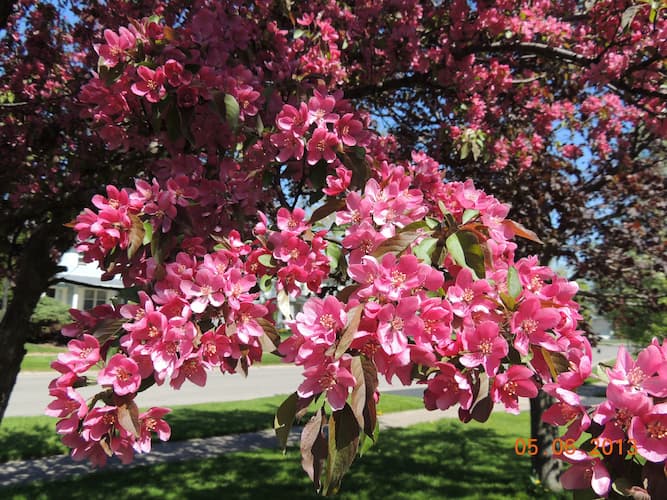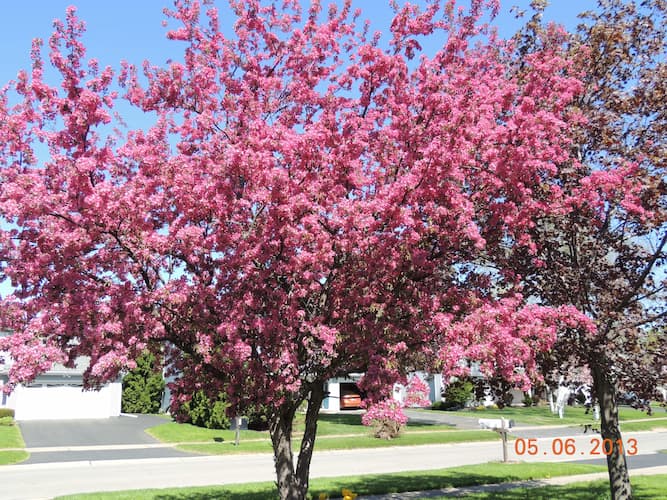How to Grow Crab Apple Trees

About Growing Crab Apple Trees as an Ornamental Tree
Crab Apple trees are fruit trees that are very popular as a landscaping ornamental. Not everyone grows them for the fruit. Rather, many people grow them for their beauty. The tree produces a profuse display of beautiful and fragrant spring flowers. The blooms are long-lasting. Also spelled “Crabapple”, these trees are popular in front yards where they put on a show for neighbors and passersby. They are a popular landscaping tree for businesses, too. If you’ve never grown one before, this guide on “How to Grow Crab Apple Trees” will help you to successfully grow this attractive, fruit-producing tree.
Crab Apples are a deciduous tree, with a long life span. However, plant diseases can significantly reduce the tree’s life. There are over 35 varieties. They grow 15 – 25 feet tall, depending upon variety. The flowers are various shades of pink, red, and white.
By definition, a Crab Apple tree is any tree that produces fruit less than 2 inches in diameter. The fruit is varying shades of red, or yellow. The small apples are edible, with a tart flavor. Generally, they are too bitter to eat raw. As you might expect, they taste like apples when cooked. People who collect the fruit for consumption, most often use them for jellies. Birds and squirrels seek these small fruits in the fall, too.
Did You Know? The seeds are called “pips”.
Crab Apple Tree Plant Specifications
Fruit Colors: Orange, red, yellow, or mottled colors.
Flowers Bloom: Late spring
Fruit Ripens: Crabapples ripen from late summer to early Fall.
Tree Height: The average crabapple tree grows 15 to 25 feet tall.
Light Requirement: Full sunlight.
Ideal pH level: 6.0 – 7.5
Plant Hardiness Zones: 3 – 8.
Lifespan: Long-lived trees, 30 to 70 years.
Number of Species: 35
Botanical Name: Malus spp.
Health and Medicinal Uses for Crab Apples
Crabapples are good for your health. And, there are several medicinal applications. Here are some of them:
- The fruit has anti-inflammatory properties.
- Make a poultice from the pulp. Then, apply it to the skin wounds to promote healing.
- Use them as a laxative for constipation.
- Consume crabapples to ease fever, gout, and indigestion.
- They have anti-cancer fighting properties.
- Antioxidants in them combat free radicals in the body which damages skin and causes aging.
Light Requirement
Crabapple trees grow best in full sunlight. For the best performance of blooms and fruit production, select a planting location where they will receive to 8 hours of bright, direct sunlight. Full sunlight also helps to avoid aplanat diseases.
Crab Apple Tree Propagation
Crab Apple trees are propagated from seeds. Collect the seeds from ripe fruit in the fall. Wash the seeds. Then, dry them on a screen or drying rack for 2-3 weeks. The seeds require a cold chilling period, called “stratification”, for 3 months or longer. Place dried seeds in a baggie and place them in the refrigerator, or another cold location like a garage or shed. But importantly, do not place them where the seeds may freeze.
You can also propagate them from cuttings. See: Propagating plants from cuttings.
Nowadays, most people buy young trees from a garden store, or online.
Planting a Crab Apple Tree
Transplant young crab apple tree saplings into your yard or garden in the spring or summer. Most likely, the container of the tree you purchased, is made of bio-degradable, heavy peat material. After planting, it will soften and break down in the moist soil, allowing the roots to easily penetrate it and grow. If the container is plastic or some other material, you need to carefully remove the roots from it during planting.
If you are growing more than one tree, space them 10 – 20 feet apart.
Dig a hole about three times as big and deeper than the root ball. Mix in plenty of rich compost into the hole, along with fresh, rich soil.
If it is in a peat container, cut slits in the container to speed up its decomposition, and to help the roots to emerge easier.
Plant the tree to a depth equal to where it is in the container. Do not plant it deeper.
Fill in around the roots with a mixture of compost and soil. Tamp down the soil lightly around the tree.
If planted in a windy area, stake the tree so it will grow straight.
Water well and deeply in the first year. Repeat deep watering frequently, to help new roots to grow and spread.

How to Grow Crab Apple Trees
Grow crab apple trees in full sun. Shaded trees produce less dense foliage, and fewer flowers and fruit. Shade also makes them more susceptible to plant disease.
Once your tree is established, it should grow well with little attention.
Using fruit tree fertilizer spikes for the first few years will help young trees to get off to a fast, healthy start. Established trees generally do not need additional fertilizers.
The roots grow deeply. Established trees usually do not need extra water.
Mulch around the tree, to keep weeds, down and maintain an attractive appearance.
Pruning Crab Apple Trees
Like other plants, pruning your crab apple tree is healthy for it. This should be done during late winter to early spring, before the new year’s growth begins.
Prune the tree yearly. First, remove dead or unhealthy branches and limbs. You can also prune branches to maintain a shapely-looking tree.
Annual pruning will help keep your tree smaller and more manageable, too.
Each spring, before buds open, apply a dormant oil fruit tree spray. This will kill a variety of insects. Apply a fruit tree spray frequently during the season, if you have problems with insects or disease. Follow the directions on the label for application and use.
We recommend spraying the trees with a general fungicide in early May and again in early July.
Disease Issues
Like other apple trees, Crab apple plant disease is common. Regular use of fruit tree sprays and fungicides will minimize this potential problem.
When and How to Harvest Crab Apples
First, you need to know when crab apples are ripe. Unripe fruit is still green. Ripe fruit is orange, red, yellow, or has mottled colors. Unripe fruit is as hard as a rock. Ripe crabapples are firm yet yields slightly when squeezed.
The ultimate ripeness test, is to cut one open and look at the seeds. The color of unripe seeds is green, pink, or white. A ripe crabapple has tan or brown seeds.
Once you have determined that the fruit is ready to pick, take the ripe ones from the tree by twisting the fruit and stem from the branches. Leave the unripe fruit on the tree to pick later.
Note: The fruit can bruise. So, handle the fruit with care.
How to Store Crab Apples
Store crab apples in a cool, dark place. Placing them in a single layer is best. If one goes bad, it is less likely to spread to neighboring fruit. Check them every few days. Remove any soft or moldy fruit. Stored in this manner, they will keep for about a month.
For longer storage, place them in a refrigerator.
Related Articles
Also, people who read this article will like:
Please support our site. Shop for:
- rmmatthews100@hotmail.com
- 585-721-6528
- Rochester, NY
©1999-2024 GardenersNet.Com, All Rights Reserved

